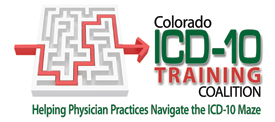ICD-10 update
Getting involved in your transition
Marilyn Rissmiller, Senior Director, Health Care Financing

The Colorado ICD-10 Training Coalition held its first webinar of 2014 on Feb. 18 with record-breaking registrations, demonstrating the great interest practice managers, staff and the medical community have in this month’s subject: How to get a practice’s physicians engaged in the transition to ICD-10.
Getting physicians engaged in ICD-10 is one of the biggest concerns that has been raised by practice administrators. While the coalition recognizes that physicians have many other demands on their time – over and above caring for their patients – that make it difficult to focus on ICD-10 coding, physicians must start learning now to avoid a 100 percent pay cut by the transition deadline, Oct. 1, 2014.
The webinar featured two practicing physicians from different practice settings and with different resources to gain a better understanding of the physician’s perspective on the ICD-10 transition.
Chet Cedars, MD, is a family physician with Lone Tree Family Practice. He has been in practice in Denver for more than 40 years and currently splits his time between part-time practice and serving as the practice administrator. His practice partner practices full time and they employ five midlevel providers.
John James, MD, is an allergist with Colorado Allergy and Asthma Centers. With locations throughout the Denver metro area, plus Castle Rock, Broomfield, Fort Collins and Greeley, the single-specialty group has 12 physicians and 10 midlevel providers.
Here are their top five takeaways for physicians.
1. Start learning about ICD-10 now. There are many resources available. Spread out the transition and the training over the next few months. “If providers understand what the additional code specificity is, what’s going to be available, and to look for those areas when they document the diagnosis, that will help,” Cedars said. “If you don’t know what’s there and you wait until Sept. 29, you’re going to be hurting.”
2. It’s not necessary for doctors to know all of the codes (or any code really); the doctor needs to know what documentation elements are required. Cedars’ electronic medical records vendor has loaded many of the ICD-10 codes onto its system, which allows the practice to begin collecting diagnoses with more specificity. The vendor will update the full system in March. Cedars said physicians can use medical assistants or nurses to document some of the codes in the chart so they have a head start. The staff can also look for those codes for the physician and he can approve or change it. As far as documentation training, Cedars said it’s still an on-the-go project. “I let the employees know how they will start documenting things like we haven’t in the past but we haven’t had any formal training at this point.”
3. Focus on the diagnoses that are critical to your own specialty/practice. This will save time and (likely) frustration. James’ practice focused on the top 50 codes in allergy and immunology. “We started to learn how to use the code set book and plan how we’re going to crosswalk from ICD-9 to ICD-10. We have a lot of education for our providers.”
4. Documentation is critical and only the practitioner can provide that. The coders can’t tell the physicians how to diagnose but they can give the physicians the tools they need for common diagnoses. This tells the physician what to document in their records so staff can pick the right ICD-10 diagnosis code. The concern is if the physician does not document what is needed, the coder can’t pick the right code, and if the coder can’t pick the code, the practice can’t submit a claim. Preparation is key and staff must have open communication with physicians before the ICD-10 transition. Cedars recommended that practice staff provide a printout to show physicians the difference in the codes and the difference in the specificities of the codes to give them an idea of what it’s about.
5. Don’t wait until Oct. 1, 2014 to improve your documentation; begin now to incorporate the new elements. “Looking at the new ICD-10-CM code set, I realize I have a lot to learn,” James said. “I could see someone looking for the first time feeling extremely overwhelmed. We have regular documentation sessions with our consultant and we get graded on our coding. It’s not always pretty but it helps us improve.” James’ practice is learning ICD-10 now and will code in both code sets in September. This allows them to check back with the coding office and ensure the coders are receiving everything they need.
What makes these two practices more prepared than most is that the physicians are involved. Cedars leads the way in his practice as the administrator. James’ practice has a committee of individuals that includes their chief operating officer, the director of clinical operations, the clinic manager and three physicians.
Physicians must be aware of what’s happening around the state and nationally instead of burying our heads in the sand, James said. He encouraged the webinar participants to engage physicians in the process: Find common ground and approach the transition as a team.
“It’s important to have an approach, take a little bit at a time and ramp it up,” James said. “We’d better get ready.”
Posted in: Colorado Medicine | Practice Management | Coding and Billing

Comments
Please sign in to view or post comments.